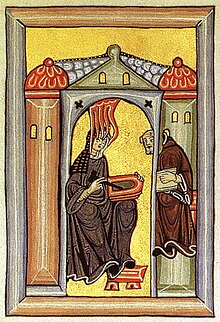Visual
A visual hallucination is "the perception of an external visual stimulus where none exists".[4] A separate but related phenomenon is a visual illusion, which is a distortion of a real external stimulus. Visual hallucinations are classified as simple or complex:
- Simple visual hallucinations (SVH) are also referred to as non-formed visual hallucinations and elementary visual hallucinations. These terms refer to lights, colors, geometric shapes, and indiscrete objects. These can be further subdivided into phosphenes which are SVH without structure, and photopsias which are SVH with geometric structures.
- Complex visual hallucinations (CVH) are also referred to as formed visual hallucinations. CVHs are clear, lifelike images or scenes such as people, animals, objects, places, etc.
For example, one may report hallucinating a giraffe. A simple visual hallucination is an amorphous figure that may have a similar shape or color to a giraffe (looks like a giraffe), while a complex visual hallucination is a discrete, lifelike image that is, unmistakably, a giraffe.
Pareidolia (/pærɪˈdoʊliə/ parr-i-DOH-lee-ə) is the tendency for incorrect perception of a stimulus as an object, pattern or meaning known to the observer, such as seeing shapes in clouds, seeing faces in inanimate objects or abstract patterns, or hearing hidden messages in music. Pareidolia can be considered a subcategory of apophenia.
Common examples are perceived images of animals, faces, or objects in cloud formations, the Man in the Moon, the Moon rabbit, and other lunar pareidolia. The concept of pareidolia may extend to include hidden messages in recorded music played in reverse or at higher- or lower-than-normal speeds, and hearing indistinct voices in random noise such as that produced by air conditioners or fans.[1]
Pareidolia was at one time considered a symptom of human psychosis, but it is now seen as a normal human tendency.[2]
Pareidolia is not confined to humans. Scientists have for years taught computers to use visual clues to "see" faces and other images.[2]
Apophenia (/æpoʊˈfiːniə/) is the tendency to mistakenly perceive connections and meaning between unrelated things.[1] The term (German: Apophänie) was coined by psychiatrist Klaus Conrad in his 1958 publication on the beginning stages of schizophrenia.[2] He defined it as "unmotivated seeing of connections [accompanied by] a specific feeling of abnormal meaningfulness".[3][4] He described the early stages of delusional thought as self-referential, over-interpretations of actual sensory perceptions, as opposed to hallucinations.[1][5]
Apophenia has come to imply a human propensity to seek patterns in random information, such as gambling.[4]
Evolution
One of the explanations put forth by evolutionary psychologists for apophenia is that it is not a flaw in the cognition of human brains but rather something that has come about through years of need. The study of this topic is referred to as error management theory.[16] One of the most accredited studies in this field is Skinner's box and superstition.
This experiment involved taking a hungry pigeon, placing it in a box and releasing a food pellet at a random time. The pigeon received a food pellet while performing some action; and so, rather than attributing the arrival of the pellet to randomness, it repeated its action, and continued to do so until another pellet fell. As the pigeon increased the number of times it performed the action, it gained the impression that it also increased the times it was "rewarded" with a pellet, although the release in fact remained entirely random.[17]
Vision (spirituality)
A vision is something seen in a dream, trance, or religious ecstasy, especially a supernatural appearance that usually conveys a revelation.[1] Visions generally have more clarity than dreams, but traditionally fewer psychological connotations. Visions are known to emerge from spiritual traditions and could provide a lens into human nature and reality.[2] Prophecy is often associated with visions.
About[edit]
Evelyn Underhill distinguishes and categorizes three types of visions:[3]
- Intellectual Visions - The Catholic dictionary defines these as supernatural knowledge in which the mind receives an extraordinary grasp of some revealed truth without the aid of sensible impressions and mystics describe them as intuitions that leave a deep impression.[4]
- Imaginary - In Teresa of Avila's The Interior Castle, an imaginary vision is defined as one where nothing is seen or heard by the senses of seeing or hearing, but where the same impression is received that would be produced upon the imagination by the senses if some real object were perceived by them.[5] Niels Christian Hvidt refers to them as visions recognized through mechanisms of the human psyche that are made up of things a soul has acquired through contact with reality.[6]
- Corporeal - A supernatural manifestation of an object to the eyes of the body. It may take place in two ways: either a figure really present strikes the retina and there determines the physical phenomenon of the vision, or an agent superior to man directly modifies the visual organ and produces in the composite a sensation equivalent to that which an external object would produce.[7] Underhill refers to this vision type as "little else than an uncontrolled externalization of inward memories, thoughts, or intuitions"[3]


No hay comentarios:
Publicar un comentario